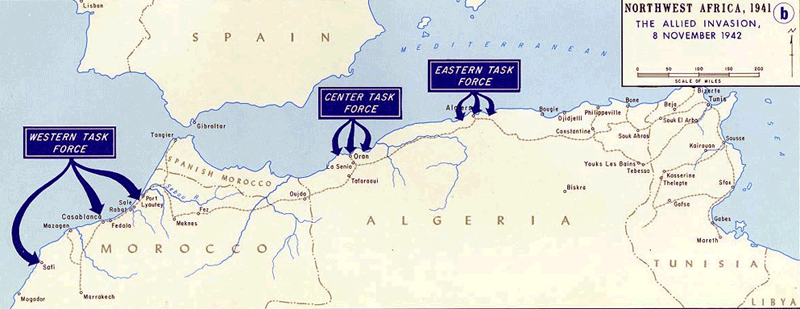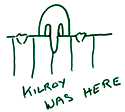The Stamford Historical Society Presents
Pride and Patriotism: Stamford’s Role in World War II
Online Edition
The Battles
Operation Torch and the Invasion of North Africa

Operation Torch was the code name for the Anglo-American invasion of French North Africa that initiated the North African Campaign, starting 8 November 1942. The objective of the attack was to clear Axis forces from North Africa and to secure better Naval control of the Mediterranean in preparation for the invasion of Southern Europe in 1943. The invasion was planned to take place in Morocco and Algeria, territory nominally in the hands of the Vichy French government. The French had 60,000 troops in Morocco as well as coastal artillery, some tanks, and aircraft with some 10 warships and 11 submarines based at Casablanca. The Allies were certain the French would not fight; however, they were unsure whether or not the French Navy might shell them. The Allies were intent on securing French cooperation in order to make for a quick advance eastward into Tunisia to attack the German rear forces. Lt. General Dwight Eisenhower was commander of the operation with headquarters at Gibraltar. The Allied forces numbered 73,500 men while the total number of French defenders was unclear.
In preparation for the assault, American Consul Robert Daniel Murphy was appointed to the consulate in Algeria to negotiate with the French commanders. He was able to make contact with a number of French officers, including General Charles Emmanuel Mast, Commander in Chief in Algiers, all of whom claimed they would support the Allies, but who also asked that a secret conference be held with a senior Allied general in Algeria. Major General Mark Wayne Clark was dispatched to Cherchell in Algeria aboard the HMS Seraph, a submarine, and met with the officers on 21 October.
The Allies planned a three-pronged amphibious assault with landings aimed to seize key ports and airport of Morocco and Algeria simultaneously. The targets were Casablanca, Oran and Algiers. The Western Task force with Casablanca as its target was an all-American unit under Major General George S. Patton, and with Rear Admiral Henry Kent Hewitt heading the naval operations. It consisted of the U.S. 2nd Armored Division and the U.S. 3rd and 9th Infantry Divisons, 35,000 troops in all. The Central Task Force, with Oran as its objective, included the 509th Parachute Infantry Battalion, the U.S. 1st Infantry Divison and the U.S. 1st Armored Division, 18,500 troops. It was commanded by Major General Lloyd Fredenall and the naval forces were under Commodore Thomas Troubridge. The Eastern Task force, with Algiers as its target, was commanded by Lt. General Kenneth Anderson and consisted of the British 78th Infantry Division and the 34th U.S. Infantry Division, 20,000 troops in all. Naval forces there were under Vice-Admiral Sir Harold Burrough. Aerial operations were split into eastern and western zones on either side of Cape Tenes, Algeria. The British Air Force was under Air Marshal Sir William Welsh and American forces under Major General James Doolittle, under the direct command of General Patton.
The Casablanca campaign called for the landing of Allied forces at three points on 8 November 1942: Safi (Operation Blackstone), Fedala (Operation Brushwood) and Mehedia-Port Lyautey (Operation Goalpost). Landing began before dawn, and given hopes for French cooperation, there was no preliminary bombardment. An attempted coup against pro-Vichy General Auguste Paul Nogues the evening before had failed, while at the same time alerting Vichy forces. At Safi, landings were successful and were accomplished without covering fire initially. When coastal batteries did fire on landing craft, Naval forces opened up. French snipers were able to pin assault troops on the beaches. Landings fell behind schedule, although air support did manage to destroy a convoy of trucks intending to reinforce Vichy positions. Safi surrendered by the afternoon of 8 Novembe,r and by 10 November the defenders were pinned down and the bulk of the invading force was on the march to Casablanca.
At Port-Lyautey, landing positions were not secure and the second wave was delayed. Defenders put up strong organized resistance and all subsequent landings were accomplished with heavy artillery bombardment. Air and carrier support helped the troops win the day and push out to capture their targets.
At Fedala, the largest landing with 19,000 men, the weather undermined the ease of the landing. Beaches were attacked shortly after dawn. General Patton landed at 8 AM, and by the end of the day beaches were secured. On 10 November Casablanca was surrounded and the city surrendered. In general, French resistance had been weak and the French Navy had not left its anchorage in Casablanca.
The Oran campaign called again for the splitting of the force into three, two west of Oran and one east. Landings at the western beaches were delayed due to a French convoy’s appearance and shallow waters and sandbars. The U.S. 1st Ranger Battalion landed east of Oran and quickly captured the shore battery at Arzew. French naval forces protected the harbor of Oran from invasion and the French Navy attacked the Allied fleet, but in the end were driven off or sunk. On 9 November Oran surrendered after suffering heavy shelling from British battleships.
While the amphibious assault went on, the first major airborne assault carried out by the U.S. was launched, with the U.S. 509th Parachute Infantry Battalion dropped near Oran. The targets were two airfields at Tafarquay and Youks-les Bains, both of which they successfully captured.
At Algiers, the invasion was coordinated by a coup lead by the French resistance on 8 November in the city of Algiers. Key targets were quickly seized. Although subsequently Vichy troops retook positions lost in the morning’s coup, the city surrendered to the invasion force by that evening. This force, also split in three, landed two groups west of Algiers and one east. There was virtually no French resistance and one French commander welcomed the Allies. The only fighting was in the city itself and it was brief.
On 8 November the 10th French Tunisian forces under General Barre left the country open for the Germans, withdrawing to the Algerian border. Fighting by French forces against Germans did not begin until 18 November. By January 1943 German troops retreating westwards from Libya reached Tunisia. Allied forces were attacked by Rommel in February at Faid Pass on the 14 and at Kasserine Pass on the 19th. Allied forces continued to retreat until the 22nd when the Germans were stopped. By March Rommel was urging Hitler to withdraw fully, but was refused. On May 6 as the culmination of Operation Vulcan, the British took Tunis and American forces reached Bizerte. By 13 May, Axis forces in Tunisia surrendered.
Given the scale of the operation casualties were light. The Allies suffered 479 to500 dead and 720 wounded. The defenders had casualties of some 1346 dead and 1997 wounded.
 Introduction
Introduction
Veterans
Battles
Stamford Service Rolls
Homefront
Exhibit Photos
Opening Day


 Introduction
Introduction